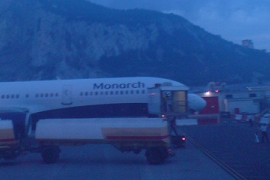For economists, Monarch’s collapse is, in many ways, not surprising – it was operating in an oligopolistic market, already hugely saturated and with little product differentiation. For others, the airline’s demise seemed to happen almost overnight. This wasn’t the case and in this blog, I will go through each of the factors which simultaneously led to Monarch’s collapse, discussing each in turn.
Monarch, Britain’s longest-surviving airline brand, ceased operations on October 2nd, leaving around 110,000 people, who were abroad at the time, in confusion and panic as to how they would return home. Indeed, this was quite a disaster to say the least. What ultimately led to Monarch’s failure was a combination of factors, including increased competition in an already crowded market, a rise in running costs resulting from exchange rate denominations and Brexit, and reduced demand given uneasy external political climates marred by terrorism.
The competition element is by far the most significant. It is worth noting that Monarch emerged out of the rapid expansion and demand for package holidays in the late 1960s and that this demand has since fallen, given that people are increasingly planning their own holidays through microsites such as AirBnB. It is also key to understand that Monarch was operating in an already over-saturated oligopolistic market. An oligopolistic market is a structure in which a small number of firms have the large majority of market share. An oligopoly is similar to a monopoly, except that rather than one firm, two or more firms dominate the market. What this means is that firms are almost indistinguishable by price and so product differentiation is key. Monarch, through a change in strategy, moved away from long haul flights and into the market of cheap short haul, which put them in direct competition with larger and more competitive airlines. For example, it is very easy to name firms that were already established in the low cost short haul flight market, including Easyjet, Whizz, Norwegian and Ryan Air. Monarch therefore faced a huge degree of competition in the low-cost market and there simply wasn’t enough room for all of these airlines to compete. Monarch essentially wasn’t differentiating itself enough to be a credible competitor and as Neil Wilson, Senior Market Analyst at ETX Capital, puts it, Monarch’s collapse was a “symptom of over-capacity and overly-aggressive pricing”. It is also a common feature of an oligopolistic market to have high barriers to entry which means that new entrants seldom come in to disrupt the market. Established competitors also tend to have strong, instantly recognisable brands- again, think Ryan Air and Easyjet. Monarch was not a well-known entrant into this market and the company’s management recognised this almost instantly, saying recently that they were looking to go back into the long-haul market.
A second factor which did not help Monarch was that many of the big costs of running an airline, namely fuel and handling charges, are denominated in dollars. This isn’t such a huge problem when global economies are operating relatively steadily but this has not necessarily been the case given the Brexit vote. Following Brexit, the pound has fallen in value relative to the dollar by approximately 10%, so Monarch was paying £50m a year more for its fuel and aircraft. In addition, British tourists were also deterred from travelling due to the weaker pound, leading to a reduction in demand. Potential rescue buyers of Monarch were also deterred by uncertainty around Brexit and whether British carriers will still have the right to operate freely in Europe once a deal has been struck.
A final factor which did not help Monarch was the fact that many of its key markets – namely Egypt and Turkey – have faced a large decrease in demand from holiday makers given the increased terror risk. As a result, Monarch was forced to decrease its prices to these destinations which, with overcapacity prices coming down, only worsened the situation in terms of Monarch’s own revenues (Hoggan, 2017).
In some ways, Monarch’s demise draws similarities with Uber’s operations in London. Running in another highly saturated market – that of the London taxi – Uber was competing with traditional black cabs and other popular companies, such as Addison Lee, Taxify and Lyft. To enter the market, Uber had to distinguish itself. It did so by incorporating the use of smartphones when hailing a cab and offering cheaper prices. Uber therefore differentiated its product both through the use of technology and price- something quickly taken into account by similar companies, given the significant growth in ride-hailing apps. Uber further ensured its success by using a surge-pricing model: one which works on charging higher prices when demand is high, which maximises revenue.
Nevertheless, in a highly competitive market and faced with increasingly negative press, Uber has faced a downturn in its market share. Whether or not the company will face a similar demise to Monarch is yet unknown as, putting economic principles aside, many await the outcome of its court appeal following last year’s TfL decision. Even if Uber is allowed to continue to operate in London, will it survive in an ever competitive, overcrowded market?
References:
Karen Hoggan (2 October 2017) “Monarch: Four reasons behind its failure” BBC News http://www.bbc.co.uk/news/business-41466722
“Oligopoly” Investopedia https://www.investopedia.com/terms/o/oligopoly.asp
Sarah Young (11 December 2013) “UK airline Monarch sees rising competition in European short-haul” Reuters https://uk.reuters.com/article/uk-monarch-competition-interview/uk-airline-monarch-sees-rising-competition-in-european-short-haul-idUKBRE9BA0UX20131211
» Next post: Automation and the Employment Market
